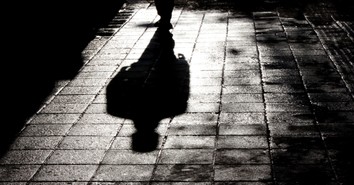Taking a Walk on the Ark: Behind the Scenes of Aronofsky's Noah

A week before Hurricane Sandy swept in with a vengeance back in October 2012, the weather in New York City couldn't have been staged more appropriately for the press tour of the set of Darren Aronofsky's longtime passion project, Noah.
Cold, damp and raining from the moment the sun came up, our call time kept getting delayed because of the less-than-stellar conditions, not that anyone complained. That just meant there was more time for strolling around Manhattan with an umbrella as we wondered what walking on Noah's Ark - or Aronofsky's vision of it, anyway - would be like.
Aside from a few film clips we were shown the night before, the project was pretty much kept under lock and key. All we knew then was that Noah was a large scale re-imagining of the biblical story and that Maximus from Gladiator (a.k.a. Russell Crowe) was playing the titular character. The rest was a little fuzzy until we hopped on a bus, crossed the Brooklyn Bridge and made our way to the set at the historic Marcy Avenue Armory.
One of the many remarkable facets of the moviemaking process is the sheer amount of people involved, and Noah was certainly no exception. Even once the sun had long since set, there was still a seemingly never-ending rotation of personnel making their way in and out, including Crowe, who stopped by to say hello.
Showing off some serious biceps, Crowe's day is done but he's still dressed in his full Noah garb, which consists of a brown tunic, roughed-up fingerless gloves and a full, wooly beard. Like many Hollywood actors he seems a whole lot smaller in person, save for the arms. But as I'd discover nearly 16 months later when I screened Noah (again in New York), his presence is decidedly larger than life on screen. Like his work in Gladiator, this feels like a role he was born to play.
A Walk to Remember
After chatting with a few of the film's key personnel (more on that in a minute), we were invited to make our way to the ark, the crafting of which involved more than a year of nailing down the design plus an additional three months to build.
Inspired by the description in the Book of Genesis, Aronofsky says they wanted to stay as true as they could to the original measurements in cubits. In modern terms, that resulted in a veritable behemoth that was 50 feet tall and 500 feet long. Constructed from wood, steel and foam, Aronofsky was intent on doing something different with the ark. For him, it was important to give the audience a different visual, not the familiar "floating houseboat with two giraffes sticking out of the top."
Boarding the ark involved a serious cardio burst. We'd been instructed to wear practical footwear, and it was quickly apparent why low-maintenance shoes were a pre-requisite. Not only was there a massive, hamstring-challenging incline leading to the ark, but once you made it inside the decks, treading lightly was a must with the sturdy but still-delicate construction. Fashioned with painstaking attention to detail, the ark was broken into three distinct decks.
"In Genesis, it talks about three decks. The bottom was for mammals, the middle was for the insects and reptiles, and the top was for birds," Aronofsky says. To keep the production from escalating into a $300+ million project, Aronofsky was forced to get creative with the animal aspect of the story. Surprisingly enough, the lack of actual living, breathing creatures didn't make the snake deck feel any less real. Crafted to look just like the real slithering things with CGI bringing them to life later, the fake snakes were still scary enough to freak me out.
But back to practical logistics: Aronofsky said it was crucial to figure out an affordable way for the animals to co-exist. "We couldn’t have them all up and moving around, otherwise it would be a $300 million movie," he shared. "So we found a way around that by setting up that Noah's wife, Navae, works with herbs, and the animals would come on the ark and fall asleep."
The decision to have the animals succumb to a state of hibernation was a creative move in response to part of the story that isn't presented in great detail in Scripture, according to Mary Parent, one of the film's producers. "When pondering the problematic situation, being stuck in a mammoth boat with all the animals, it kind of makes you wonder if it could have played out that way," she says.
Bringing an Epic Vision to Life
While ideas for films may come and go, Aronofsky has had Noah on the brain for a good, long while. Back when the director was 13, his teacher commissioned the class to write about a pretty broad subject: Peace. Naturally, his writing could've gone in a million different directions, but teenage Darren chose to write a poem about the dove that God sends Noah's way. Aronofsky did more than satisfy a class requirement; the burgeoning writer won a United Nations contest for his work.
Through the years, the story of Noah has remained close to him, and Aronofsky, along with his frequent collaborator Ari Handel, wrote this script together. Its first iteration was a graphic novel written in French and titled Noé. But the director's persistence in getting the project made into a movie was rewarded when he struck a deal with Paramount and New Regency Pictures for a reported budget of $130 million.
While much has already been written about the filmmaker's intentions and agenda with Noah, Aronofsky isn't surprised by the varying responses. For him, Noah is so many things, but above all, it's a story of hope.
"At the very core of the film is this family drama. It's about a mother and a father who are living in a very difficult time. They have to navigate their children through that and hopefully, find a better place and a better beginning for them," Aronofsky says. "There's faith, there's hope, and there's also takeaway about being a good, loving parent. There's so much there."
Cale Boyter, an associate producer on the film, views Noah as an opportunity to make mainstream movies that connect with people of faith.
"I thought a lot about that very thing—how does mainstream media connect with people of faith? What does that look like?" he ponders. "People of faith in middle America love movies, but they kind of hate Hollywood. It's always been something we've been battling against. I talked a little about the enormous opportunity of having something like Noah with this level of talent involved doing something biblical. When I read the script back in 2009, it blew me away. The message of mercy and the power of God's love is dramatized in this movie so beautifully. And I'd never thought about Noah's story that way."
Audiences - believers and non-believers alike - will finally be able to decide what they think when the film opens nationwide on March 28.
Running 138 minutes, Noah, starring Crowe, Jennifer Connelly, Logan Lerman, Emma Watson and Anthony Hopkins is rated PG-13 for violence, disturbing images and brief suggestive content.
Publication date: March 20, 2014
Originally published March 20, 2014.







